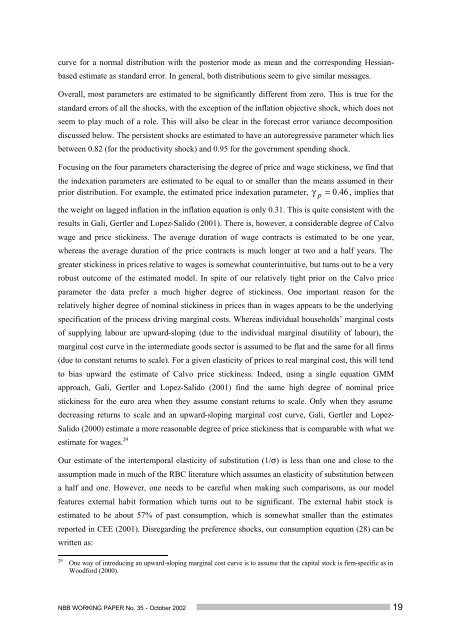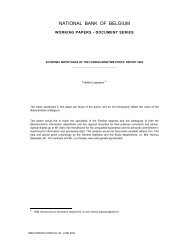An estimated dynamic stochastic general equilibrium model of the ...
An estimated dynamic stochastic general equilibrium model of the ...
An estimated dynamic stochastic general equilibrium model of the ...
Create successful ePaper yourself
Turn your PDF publications into a flip-book with our unique Google optimized e-Paper software.
curve for a normal distribution with <strong>the</strong> posterior mode as mean and <strong>the</strong> corresponding Hessianbasedestimate as standard error. In <strong>general</strong>, both distributions seem to give similar messages.Overall, most parameters are <strong>estimated</strong> to be significantly different from zero. This is true for <strong>the</strong>standard errors <strong>of</strong> all <strong>the</strong> shocks, with <strong>the</strong> exception <strong>of</strong> <strong>the</strong> inflation objective shock, which does notseem to play much <strong>of</strong> a role. This will also be clear in <strong>the</strong> forecast error variance decompositiondiscussed below. The persistent shocks are <strong>estimated</strong> to have an autoregressive parameter which liesbetween 0.82 (for <strong>the</strong> productivity shock) and 0.95 for <strong>the</strong> government spending shock.Focusing on <strong>the</strong> four parameters characterising <strong>the</strong> degree <strong>of</strong> price and wage stickiness, we find that<strong>the</strong> indexation parameters are <strong>estimated</strong> to be equal to or smaller than <strong>the</strong> means assumed in <strong>the</strong>irprior distribution. For example, <strong>the</strong> <strong>estimated</strong> price indexation parameter, γ p = 0. 46 , implies that<strong>the</strong> weight on lagged inflation in <strong>the</strong> inflation equation is only 0.31. This is quite consistent with <strong>the</strong>results in Gali, Gertler and Lopez-Salido (2001). There is, however, a considerable degree <strong>of</strong> Calvowage and price stickiness. The average duration <strong>of</strong> wage contracts is <strong>estimated</strong> to be one year,whereas <strong>the</strong> average duration <strong>of</strong> <strong>the</strong> price contracts is much longer at two and a half years. Thegreater stickiness in prices relative to wages is somewhat counterintuitive, but turns out to be a veryrobust outcome <strong>of</strong> <strong>the</strong> <strong>estimated</strong> <strong>model</strong>. In spite <strong>of</strong> our relatively tight prior on <strong>the</strong> Calvo priceparameter <strong>the</strong> data prefer a much higher degree <strong>of</strong> stickiness. One important reason for <strong>the</strong>relatively higher degree <strong>of</strong> nominal stickiness in prices than in wages appears to be <strong>the</strong> underlyingspecification <strong>of</strong> <strong>the</strong> process driving marginal costs. Whereas individual households’ marginal costs<strong>of</strong> supplying labour are upward-sloping (due to <strong>the</strong> individual marginal disutility <strong>of</strong> labour), <strong>the</strong>marginal cost curve in <strong>the</strong> intermediate goods sector is assumed to be flat and <strong>the</strong> same for all firms(due to constant returns to scale). For a given elasticity <strong>of</strong> prices to real marginal cost, this will tendto bias upward <strong>the</strong> estimate <strong>of</strong> Calvo price stickiness. Indeed, using a single equation GMMapproach, Gali, Gertler and Lopez-Salido (2001) find <strong>the</strong> same high degree <strong>of</strong> nominal pricestickiness for <strong>the</strong> euro area when <strong>the</strong>y assume constant returns to scale. Only when <strong>the</strong>y assumedecreasing returns to scale and an upward-sloping marginal cost curve, Gali, Gertler and Lopez-Salido (2000) estimate a more reasonable degree <strong>of</strong> price stickiness that is comparable with what weestimate for wages. 29Our estimate <strong>of</strong> <strong>the</strong> intertemporal elasticity <strong>of</strong> substitution (1/σ) is less than one and close to <strong>the</strong>assumption made in much <strong>of</strong> <strong>the</strong> RBC literature which assumes an elasticity <strong>of</strong> substitution betweena half and one. However, one needs to be careful when making such comparisons, as our <strong>model</strong>features external habit formation which turns out to be significant. The external habit stock is<strong>estimated</strong> to be about 57% <strong>of</strong> past consumption, which is somewhat smaller than <strong>the</strong> estimatesreported in CEE (2001). Disregarding <strong>the</strong> preference shocks, our consumption equation (28) can bewritten as:29One way <strong>of</strong> introducing an upward-sloping marginal cost curve is to assume that <strong>the</strong> capital stock is firm-specific as inWoodford (2000).NBB WORKING PAPER No. 35 - October 2002 19
















